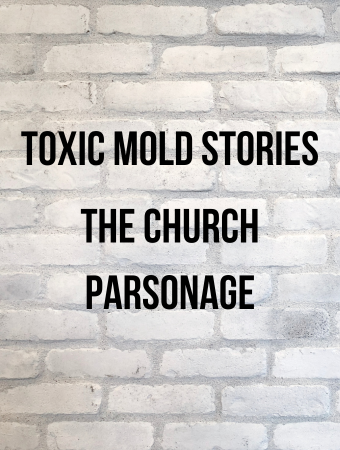
If you know me well, you already know that I’m a life-long Lutheran. I’m the daughter of a Lutheran pastor, and married to a Lutheran pastor. I went to Lutheran grade schools growing up. I went to a Lutheran university for my undergraduate degree. Before I became a stay at home mom and homeschooler, I was a Lutheran teacher. You could say I’ve been around the Lutheran block. In my lifetime, I’ve been a member of (or steadily attended) eleven different Lutheran churches across four different states. With all of this Lutheran love inside of me, I have some critical words to share. Within the wider world of the Lutheran Church Missouri Synod, there are too many toxic mold stories originating from the church parsonage.
(I acknowledge that this likely goes on in other denominations, but I am familiar with what is happening within my own church body.)
THE FUNDAMENTAL FLAW WITH THE PARSONAGE MODEL
A parsonage is a house owned by a church. Generally, a church will own a parsonage because housing options around the church are scarce, or because those options are too expensive for a church worker to purchase on their own. A parsonage is an asset of the church. The church sees equity for their investment, not the church worker. Thus, the maintenance of the house falls to the church. So when a roof needs to be replaced or a pipe bursts, the church is responsible for the repairs.
At every Lutheran church I’ve ever attended, the “Trustee” in charge of maintenance has been a church member who serves the position unpaid. It’s generally an elected position that people try to avoid. In most cases, the position turns over every few years. My point is that a parsonage is never maintained at the same standard as someone’s home. When you own a home, you make improvements. You tackle problems immediately, because your personal investment is at stake.
Generally speaking, no one owns a parsonage. No one cares deeply about its condition or maintenance. “The Church” isn’t any one person. It’s a collection of people who pass off responsibility to one another, so that no one knows what was done three years ago or ten. There’s usually no money in the church budget for repairs. Band-aids and duct tape are used where, in a private home, quality repairs would be made.
There may be some Lutheran churches who deeply value the condition of their church workers’ housing. There may be immaculate, well-maintained parsonages that are worthy of praise. I’m making the case, that such a thing is sadly not the norm.

A pretty house is not necessarily a safe house.
THE NUMBERS DON’T LIE
In 2018, my family moved out of a parsonage that we had lived in for five years. During those five years, my health steadily declined until I was nearly bed-ridden at 35 years of age. After being hospitalized for twelve days, my husband and I tested the home for toxic mold. While the mold was not visible to the naked eye, the house came back highly toxic. Since our hasty exit, I have met THIRTEEN other Lutheran church workers who have become tragically ill due to mold in a parsonage. Since this website’s increased traffic, I am contacted more frequently by those suspecting mold in a parsonage or those who already have test results to confirm mold in a parsonage. The number of church workers I’ve met who’ve dealt with this, or currently walk this path, continues to grow rapidly.
Many of these individuals or families have lost everything. In every case, at least one family member (if not all) is gravely ill. They’ve all had to walk away from the parsonage they called home. All have had to dispose of contents, though some more than others. (That decision is based on the toxicity of the home as well as the individual’s personal sensitivity to the mold.) There is tragedy in every story. There is fear and pain and loss. In every story, relationships fracture. The numbers don’t lie. This problem is endemic.


WHY ARE SO MANY PARSONAGES INFESTED WITH MOLD?
There can be toxic mold in any home. In fact, it’s estimated that 50-70% of the homes in America have detectable mold. High humidity encourages the growth of mold, as does water intrusion. Nearly all building materials are made from organic matter. With the introduction of moisture, mold grows within 48 hours unless the source of the moisture is halted, and the material dried thoroughly.
So many things can lead to mold in a home. The problem can be external to the walls of the home. The grading may be “negative” in that it slopes toward the foundation. The home may have no gutters, or gutters that terminate too close to the house. The roof design may have flaws that encourage water to collect at a chimney or ridge. The weep holes may be blocked or not installed at all. The brick may have been painted, which keeps the exterior from “breathing” as its designed to do.
Inside the home, a bathroom may have no fan, or that fan may terminate into the attic space. Windows leak. Sometimes window frames trap moisture in the walls. Plumbing breaks. Pipes slow leak behind sheetrock. Things happen. The speed at which these problems are solved is of paramount importance. How many decisions in a church, especially decisions which involve money, happen quickly? These problems are often ignored or neglected. Again, no one person has an individual stake in the home.



SYMPTOMS OF MOLD TOXICITY
When we left our moldy parsonage in 2018, a member of our church leadership told me that I couldn’t be sick from the parsonage because I had no respiratory symptoms. When I relayed the information my doctor provided, I was dismissed because this person “knew” that mold couldn’t do such a thing. This conversation is not unique and is repeated often when church workers find themselves in this situation. The reality is that toxic mold affects people differently. There are many possible symptoms. Here is a list, though not exhaustive. The symptoms I experienced are in bold.
- Coughing
- Difficulty breathing
- Wheezing
- Runny nose
- Sinus inflammation
- Decreased sex hormones
- Infertility
- Rash
- Blurred vision
- Fatigue
- Frequent headaches
- Abdominal pain, bloating, and diarrhea
- Anxiety
- Weight gain
- Difficulty concentrating
- Hair loss
- Increased thirst
- Joint pain
- Lightheadedness
- Muscle cramps
- Sensitivity to light
- Tingling and numbness in hands and feet
- Elevated liver enzymes
- Panic attacks
- Decreased short term memory
- Word finding difficulty
- Brain fog
- Difficulty making decisions
- Multiple Chemical Sensitivity
- Mast Cell Activation Syndrome
It took me YEARS to recover from the damage that house did to my body. After spending tens of thousands of dollars on alternative medicine and medical care, I’m finally able to live a normal life. Personal sensitivity and recovery are different for everyone. It’s dependent upon each person’s genetic makeup and the toxic load they’ve been exposed to throughout life. You can think of the body’s ability to handle toxicities like a cup. You can only handle so much before the body’s cup is full and the resulting overflow of symptoms pour out. While one may enter the house with a cup that’s nearly full already, another may enter with an empty cup that never reaches overflow.

Mold does not have to be visible to be dangerous.
THE SECONDARY PROBLEM – BROKEN RELATIONSHIPS
Aside from the damage to our church workers’ health, mental well-being, and financial stability, toxic mold in a parsonage leaves behind a swathe of broken relationships. Inevitably, I’ve seen it play out like this: Someone discovers toxic mold in the parsonage. One of two things will happen. Either the church tries to avoid responsibility for the issue, OR the church takes initial steps to solve the problem. Perhaps the church pays for a mold remediation. (These are not cheap and may range anywhere from $10,000-$50,000.)
If the church pays for a mold remediation, they generally expect the church worker to move back in once the house is “clean.” Unfortunately, most remediations are botched. We tested our parsonage before and after remediation. It tested much more toxic after the fact. This is because, if not done well, remediation actually stirs up spores and makes the environment more toxic than it had been. It’s no surprise, then, that church workers often react to the parsonage even after a remediation. At that point, the church generally becomes frustrated with the church worker, because they made an effort and it wasn’t “good enough.”
Going back to the church who tries to avoid accepting responsibility for the issue, this often displays itself as labeling. The church worker is labeled “crazy” or “demanding” or “ungrateful.” When the church worker is at rock bottom with no contents, and sometimes no place to call home, the church pretends that nothing is happening. The issue is hushed. There is no help or aid or empathy given to the church worker’s family.
FRUSTRATION AND BROKEN TRUST
It is very difficult for someone coming out of a moldy environment to find safe housing. Go back to that statistic. 50-70% of the homes in America have notable mold problems. Sometimes a church worker moves into a new property only to find that they are also reactive there. Again, if a church has helped that worker into the temporary housing only to find that it’s not “good enough,” frustration runs high. Accusations are often made.
In nearly all of the cases that I’m familiar with first-hand, the fundamental trust between church and church worker is broken. Either the church loses confidence in the sanity or capability of their church worker, or the church worker is emotionally hurt by the church’s lack of empathy. As Christians we are to care for the church worker. What does it say about a church that leaves their own church worker to sleep on the floor of an empty apartment for weeks or months on end?
THE ANSWER
Okay. So to be honest, I don’t know the answer. I think, in part, the answer is education. I think church workers need to know how to examine a parsonage before they move in and call it home. Church workers must recognize a dangerous property. They need to know the real symptoms of toxic mold exposure. Church workers should not deteriorate for years on end when the house might be the cause. Toxic mold needs to be on the radar of every church worker who considers a parsonage.
The other side of this issue belongs to the churches who own these parsonages. I don’t think we can change the management process. The “Trustee” method of management is widespread. No one has a personal stake in these homes. Even so, I think that church boards and church leadership need to understand the weight they carry when they choose to own a parsonage. A church worker’s health, mental well-being, and financial stability lay in their hands. By owning a parsonage, they have accepted a massive, important responsibility. They need to understand the danger of toxic mold. Bleach and paint do not fix mold. It can’t be scrubbed away. Each parsonage needs to, somehow, have the same value as the houses the church members call home.






Leave a Reply
You must be logged in to post a comment.